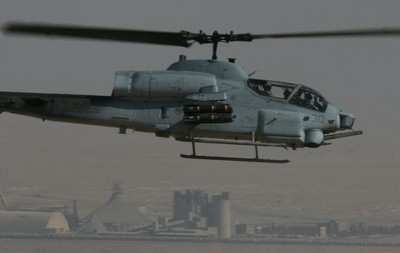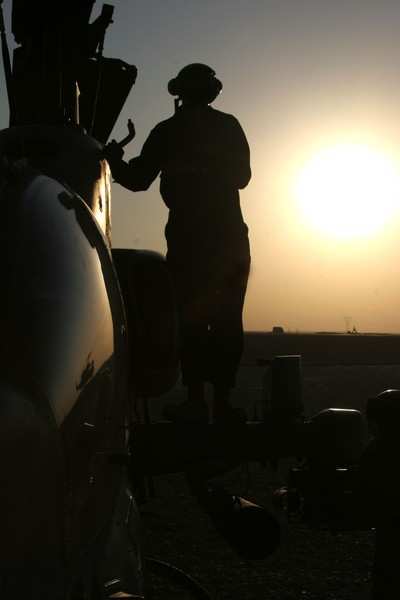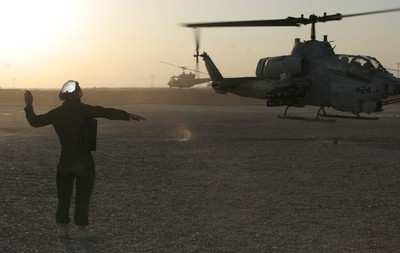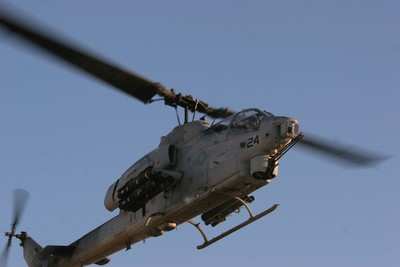Supporting Marines On Ground
Marines flying AH-1W
Super Cobras, soaring through the skies of Iraq, are growing
accustomed to using precision guided ordnance, maximizing the
damage to their targets while minimizing collateral damage.
Since arriving in western Iraq during September, the Gunfighters
of Marine Light Attack Helicopter Squadron 369 have continuously
dropped precision guided ordnance on the enemy in support of
ongoing operations. The Gunfighters, from Al Qaim, Iraq, dropped
their 100th precision-guided AGM-114 Hellfire missile, Nov. 17.
“We are destroying target after target in support of
ground combat brethren,” said Maj. John Barranco, the
officer-in-charge of the Gunfighters’ Al Qaim detachment and
a Boston native.
“It’s been rare to have a day go by without contact
with the enemy. We have a lot of young Cobra pilots. Some are on
their first deployment, some are seeing combat for the first time.
But, they are all doing a tremendous job.”

The Cobra is a flying arsenal. Besides Hellfires, the
Gunfighters’ pilots said they have utilized the .20 mil.
turret gun, which fires semi-armor piercing, high explosive
incendiary rounds, and eliminated the enemy threat on the ground
with 5 and 2.75 inch rockets. However, the pilots stressed they are
primarily using the Hellfire, because it is so precise.
Barranco said Lt. Dean Oltman, a Cobra pilot with the
Gunfighters, shot five Hellfire missiles during one of his first
flights here, five times more than he had shot before.
“It shows great courage to be able to do that while being
shot at in combat,” said Barranco. “Oltman is just one
example, all of our lieutenants flying Cobras under the same stress
are continually doing a great job.”

Barranco stressed that the Cobra pilots would not be able to
fire precision guided ordnance, supporting the Marines on the
ground, without amazing Marines on the maintenance level, working
day and night to keep the Cobras in the air.
“When the Cobras return, after firing their missiles, you
really feel that all your hard work is worth it,” said Lance
Cpl. Doug Johnson, an ordnanceman with the Gunfighters and a
Houston native. “In a 24-hour period, we shot 10 precision
guided missiles in support of Operation Steel Curtain in Husaybah.
With the Hellfires, they are taking out enemy buildings, as well as
improvised explosive devices.”
Johnson said he enjoys when things get busy and he is constantly
working because he knows when the Cobras kill insurgents,
they’re saving Marines and innocent civilian lives.
“We use the Hellfires a lot on insurgents in
buildings,” said Capt. Aaron Haines, a Cobra pilot with the
Gunfighters and a Woodland Park, Colo., native. “Forward air
controllers call in the coordinates, we locate it with sensors on
the Cobra and blow the target up.”

Haines said the Cobra pilots’ primary missions are close
air support for the Marines on the ground and providing security
for casualty evacuations.
“We have been very successful supporting current
operations from Al Qaim,” said Haines. “There is more
shooting going on here anywhere else in Iraq. The cold weather only
gives our birds more power, nothing slows us down.”
The Gunfighters throughout Iraq are thriving while facing combat
on a daily basis. Although their morale is high, they have also
experienced the dark side of this war. One of their Cobras crashed,
Nov. 2, killing pilots Capt. Mike Martino and Maj. Jerry
Bloomfield.

“Whenever I look at a Cobra, I’m reminded of
them,” said Sgt. Brainard D. Shirley, the Gunfighters’
airframes collateral duty quality assurance representative and a
Kirtland, N.M, native. “To me, their sacrifice represents all
of us. The causes we believe in and freedom we are trying to help
these people achieve. It makes us want to push harder to do the
best job we can to keep these aircraft flying.” [ANN Salutes
Cpl. Cullen J. Tiernan, 2nd Marine Aircraft Wing]
 Aero-News: Quote of the Day (04.28.25)
Aero-News: Quote of the Day (04.28.25) ANN's Daily Aero-Term (04.28.25): Decision Altitude (DA)
ANN's Daily Aero-Term (04.28.25): Decision Altitude (DA) ANN's Daily Aero-Linx (04.28.25)
ANN's Daily Aero-Linx (04.28.25) Airborne-Flight Training 04.24.25: GA Refocused, Seminole/Epic, WestJet v TFWP
Airborne-Flight Training 04.24.25: GA Refocused, Seminole/Epic, WestJet v TFWP Aero-News: Quote of the Day (04.29.25)
Aero-News: Quote of the Day (04.29.25)






